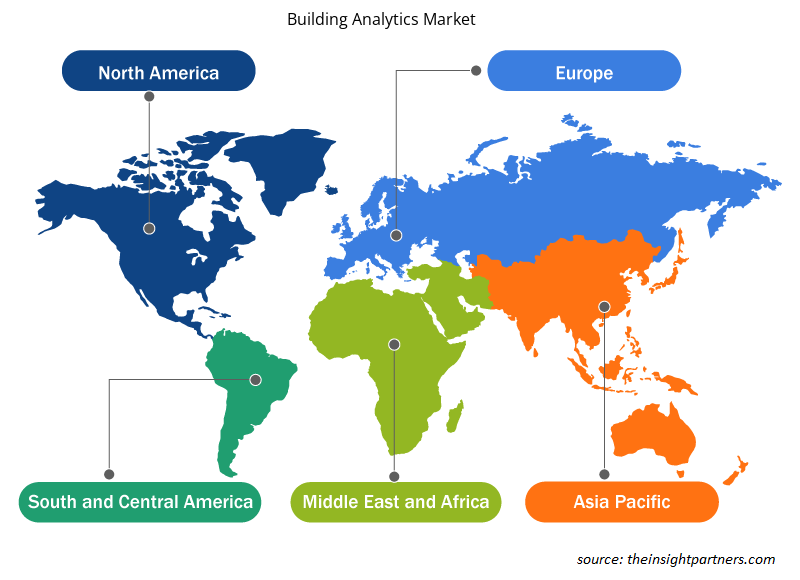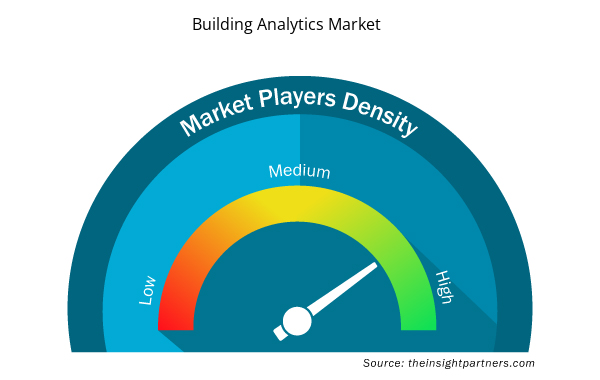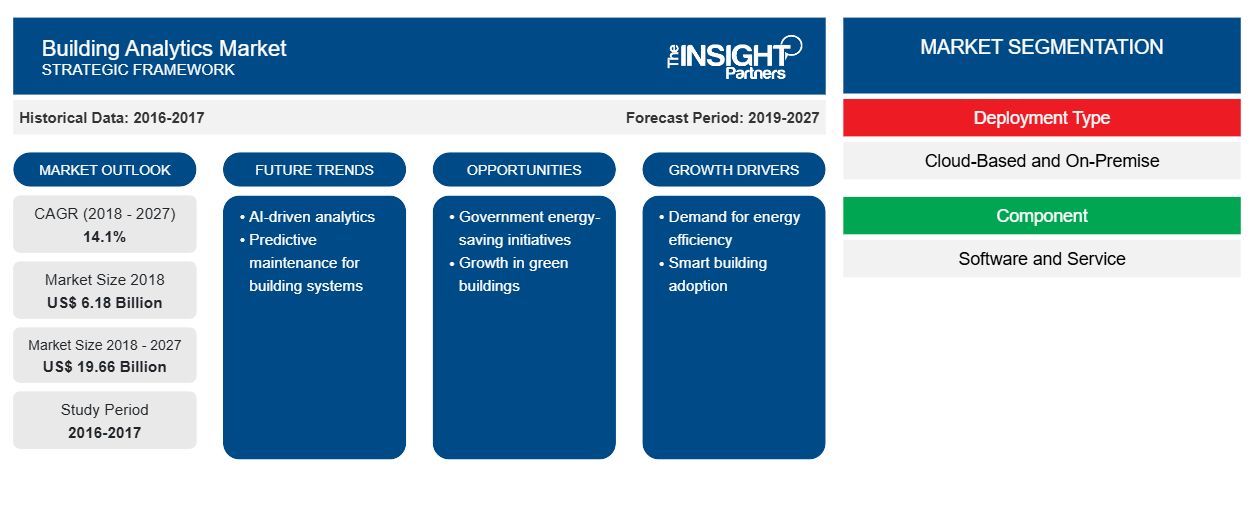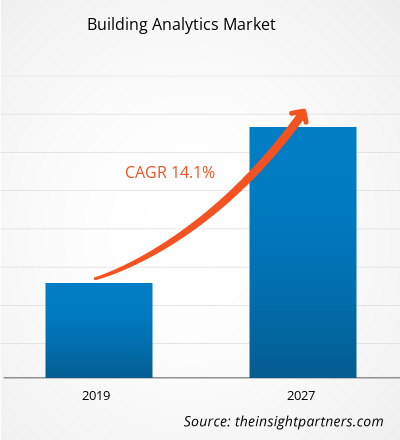El mercado global de análisis de edificios se valoró en US$ 6.181,4 millones en 2018 y se espera que crezca a una CAGR del 14,1% entre 2019 y 2027.
El mercado de análisis de edificios está experimentando un crecimiento en todo el mundo; se espera que los crecientes precios de la energía, las pautas energéticas de los edificios cada vez más estrictas y el logro de la máxima eficiencia operativa para la gestión de edificios e instalaciones sean las principales fuerzas impulsoras del mercado en los próximos años.
El informe se centra en una segmentación en profundidad del mercado de análisis de edificios en función del tipo de implementación, componente, tipo de edificio y aplicación. La segmentación geográfica del informe cubre cinco regiones principales, entre ellas: América del Norte, Europa, Asia-Pacífico (APAC), Oriente Medio y África (MEA) y América del Sur (SA). El mercado regional se ha segmentado aún más por países respectivos. Por aplicación, la gestión energética representó la mayor participación en el mercado de análisis de edificios en 2018.
Personalice este informe según sus necesidades
Obtendrá personalización en cualquier informe, sin cargo, incluidas partes de este informe o análisis a nivel de país, paquete de datos de Excel, así como también grandes ofertas y descuentos para empresas emergentes y universidades.
- Obtenga las principales tendencias clave del mercado de este informe.Esta muestra GRATUITA incluirá análisis de datos, desde tendencias del mercado hasta estimaciones y pronósticos.
El informe tiene como objetivo proporcionar una descripción general del mercado global de análisis de edificios con una segmentación detallada del mercado. Además, analiza el escenario actual del mercado de análisis de edificios y pronostica el mercado hasta 2027. El informe cubre la dinámica del mercado que afecta al mercado de análisis de edificios durante el período de pronóstico. Además, el informe analiza el escenario competitivo, las tendencias geográficas y las oportunidades en el mercado de análisis de edificios con respecto a todas las regiones geográficas. El informe también incluye los perfiles detallados de las empresas de los actores clave en el mercado de análisis de edificios junto con sus estrategias de mercado. El informe también proporciona PEST junto con el análisis FODA para todas las empresas perfiladas en el informe.
En la actualidad, las tasas de penetración del mercado de análisis de edificios en la región europea son más altas que en cualquier otro mercado del mundo. La Directiva de Eficiencia Energética de la Unión Europea, lanzada en 2012, estableció un conjunto de medidas obligatorias para ayudar a la UE a alcanzar su objetivo de eficiencia energética del 20% para 2020. La Directiva requiere que todos los países de la UE utilicen la energía de manera más eficiente a lo largo de la cadena energética, es decir, desde la producción hasta el consumo final. Además, en 2016, se propuso una actualización de la Directiva de Eficiencia Energética, que incluía un nuevo objetivo de eficiencia energética del 30% para 2030, así como medidas para cumplir con el nuevo objetivo. En la UE, los edificios representan alrededor del 40% del consumo total de energía y el 36% de las emisiones totales de CO2. Además, alrededor del 35% de los edificios de la UE tienen más de 50 años y casi el 75% del parque de edificios es energéticamente ineficiente, aunque solo entre el 0,4 y el 1,2% del parque de edificios se restaura cada año. Por lo tanto, una mayor restauración de los edificios existentes tiene la perspectiva de generar ahorros sustanciales de energía. Estos hechos brindan una oportunidad próspera para el crecimiento del mercado de análisis de edificios.
Perspectivas regionales del mercado de análisis de edificios
Los analistas de Insight Partners explicaron en detalle las tendencias y los factores regionales que influyen en el mercado de análisis de edificios durante el período de pronóstico. Esta sección también analiza los segmentos y la geografía del mercado de análisis de edificios en América del Norte, Europa, Asia Pacífico, Oriente Medio y África, y América del Sur y Central.

- Obtenga datos regionales específicos para el mercado de análisis de edificios
Alcance del informe de mercado de análisis de edificios
| Atributo del informe | Detalles |
|---|---|
| Tamaño del mercado en 2018 | 6.180 millones de dólares estadounidenses |
| Tamaño del mercado en 2027 | US$ 19,66 mil millones |
| Tasa de crecimiento anual compuesta (CAGR) global (2018-2027) | 14,1% |
| Datos históricos | 2016-2017 |
| Período de pronóstico | 2019-2027 |
| Segmentos cubiertos | Por tipo de implementación
|
| Regiones y países cubiertos | América del norte
|
| Líderes del mercado y perfiles de empresas clave |
|
Densidad de actores del mercado de análisis de edificios: comprensión de su impacto en la dinámica empresarial
El mercado de análisis de edificios está creciendo rápidamente, impulsado por la creciente demanda de los usuarios finales debido a factores como la evolución de las preferencias de los consumidores, los avances tecnológicos y una mayor conciencia de los beneficios del producto. A medida que aumenta la demanda, las empresas amplían sus ofertas, innovan para satisfacer las necesidades de los consumidores y aprovechan las tendencias emergentes, lo que impulsa aún más el crecimiento del mercado.
La densidad de actores del mercado se refiere a la distribución de las empresas o firmas que operan dentro de un mercado o industria en particular. Indica cuántos competidores (actores del mercado) están presentes en un espacio de mercado determinado en relación con su tamaño o valor total de mercado.
Las principales empresas que operan en el mercado de análisis de edificios son:
- Schneider Electric
- Corporación International Business Machines (IBM)
- Fundición del cielo
- Sistemas ambientales, Inc.
- Servicios de información de ENGIE Inc.
Descargo de responsabilidad : Las empresas enumeradas anteriormente no están clasificadas en ningún orden particular.

- Obtenga una descripción general de los principales actores clave del mercado de análisis de edificios
Algunos de los principales actores que operan en este mercado son (en orden alfabético) a saber: Acorn Engineering Group Limited, Arup Group, AT Kearney, Buildingiq, Buildinglogix, Buildpulse, Coppertree Analytics, Crestron Electronics, Delta Electronics, Ecovox, Energy Advantage, Enernoc, Engie Insight, Environmental Systems Inc., General Electric, Gooee, Gridpoint, Honeywell, IBM Corporation, Iconics, Schneider Electric, Senseware, Siemens, SkyFoundry, Waibel Energy Systems, Xchanging PLC (CSC Computer Sciences International Operations Limited) entre otros.
- Análisis histórico (2 años), año base, pronóstico (7 años) con CAGR
- Análisis PEST y FODA
- Tamaño del mercado Valor/volumen: global, regional, nacional
- Industria y panorama competitivo
- Conjunto de datos de Excel



Report Coverage
Revenue forecast, Company Analysis, Industry landscape, Growth factors, and Trends

Segment Covered
This text is related
to segments covered.

Regional Scope
North America, Europe, Asia Pacific, Middle East & Africa, South & Central America

Country Scope
This text is related
to country scope.
Trends and growth analysis reports related to Technology, Media and Telecommunications : READ MORE..
The List of Companies
1. Schneider Electric
2. International Business Machines (IBM) Corporation
3. SkyFoundry
4. Environmental Systems, Inc.
5. ENGIE Insight Services Inc
6. Senseware, Inc.
7. Gooee
8. Acorn Engineering Group Limited
9. Waibel Energy Systems
10. BuildingIQ, Inc
11. Siemens AG
12. General Electric (GE)
13. Iconics, Inc.
14. Coppertree Analytics
15. Delta Electronics
The Insight Partners performs research in 4 major stages: Data Collection & Secondary Research, Primary Research, Data Analysis and Data Triangulation & Final Review.
- Data Collection and Secondary Research:
As a market research and consulting firm operating from a decade, we have published and advised several client across the globe. First step for any study will start with an assessment of currently available data and insights from existing reports. Further, historical and current market information is collected from Investor Presentations, Annual Reports, SEC Filings, etc., and other information related to company’s performance and market positioning are gathered from Paid Databases (Factiva, Hoovers, and Reuters) and various other publications available in public domain.
Several associations trade associates, technical forums, institutes, societies and organization are accessed to gain technical as well as market related insights through their publications such as research papers, blogs and press releases related to the studies are referred to get cues about the market. Further, white papers, journals, magazines, and other news articles published in last 3 years are scrutinized and analyzed to understand the current market trends.
- Primary Research:
The primarily interview analysis comprise of data obtained from industry participants interview and answers to survey questions gathered by in-house primary team.
For primary research, interviews are conducted with industry experts/CEOs/Marketing Managers/VPs/Subject Matter Experts from both demand and supply side to get a 360-degree view of the market. The primary team conducts several interviews based on the complexity of the markets to understand the various market trends and dynamics which makes research more credible and precise.
A typical research interview fulfils the following functions:
- Provides first-hand information on the market size, market trends, growth trends, competitive landscape, and outlook
- Validates and strengthens in-house secondary research findings
- Develops the analysis team’s expertise and market understanding
Primary research involves email interactions and telephone interviews for each market, category, segment, and sub-segment across geographies. The participants who typically take part in such a process include, but are not limited to:
- Industry participants: VPs, business development managers, market intelligence managers and national sales managers
- Outside experts: Valuation experts, research analysts and key opinion leaders specializing in the electronics and semiconductor industry.
Below is the breakup of our primary respondents by company, designation, and region:

Once we receive the confirmation from primary research sources or primary respondents, we finalize the base year market estimation and forecast the data as per the macroeconomic and microeconomic factors assessed during data collection.
- Data Analysis:
Once data is validated through both secondary as well as primary respondents, we finalize the market estimations by hypothesis formulation and factor analysis at regional and country level.
- Macro-Economic Factor Analysis:
We analyse macroeconomic indicators such the gross domestic product (GDP), increase in the demand for goods and services across industries, technological advancement, regional economic growth, governmental policies, the influence of COVID-19, PEST analysis, and other aspects. This analysis aids in setting benchmarks for various nations/regions and approximating market splits. Additionally, the general trend of the aforementioned components aid in determining the market's development possibilities.
- Country Level Data:
Various factors that are especially aligned to the country are taken into account to determine the market size for a certain area and country, including the presence of vendors, such as headquarters and offices, the country's GDP, demand patterns, and industry growth. To comprehend the market dynamics for the nation, a number of growth variables, inhibitors, application areas, and current market trends are researched. The aforementioned elements aid in determining the country's overall market's growth potential.
- Company Profile:
The “Table of Contents” is formulated by listing and analyzing more than 25 - 30 companies operating in the market ecosystem across geographies. However, we profile only 10 companies as a standard practice in our syndicate reports. These 10 companies comprise leading, emerging, and regional players. Nonetheless, our analysis is not restricted to the 10 listed companies, we also analyze other companies present in the market to develop a holistic view and understand the prevailing trends. The “Company Profiles” section in the report covers key facts, business description, products & services, financial information, SWOT analysis, and key developments. The financial information presented is extracted from the annual reports and official documents of the publicly listed companies. Upon collecting the information for the sections of respective companies, we verify them via various primary sources and then compile the data in respective company profiles. The company level information helps us in deriving the base number as well as in forecasting the market size.
- Developing Base Number:
Aggregation of sales statistics (2020-2022) and macro-economic factor, and other secondary and primary research insights are utilized to arrive at base number and related market shares for 2022. The data gaps are identified in this step and relevant market data is analyzed, collected from paid primary interviews or databases. On finalizing the base year market size, forecasts are developed on the basis of macro-economic, industry and market growth factors and company level analysis.
- Data Triangulation and Final Review:
The market findings and base year market size calculations are validated from supply as well as demand side. Demand side validations are based on macro-economic factor analysis and benchmarks for respective regions and countries. In case of supply side validations, revenues of major companies are estimated (in case not available) based on industry benchmark, approximate number of employees, product portfolio, and primary interviews revenues are gathered. Further revenue from target product/service segment is assessed to avoid overshooting of market statistics. In case of heavy deviations between supply and demand side values, all thes steps are repeated to achieve synchronization.
We follow an iterative model, wherein we share our research findings with Subject Matter Experts (SME’s) and Key Opinion Leaders (KOLs) until consensus view of the market is not formulated – this model negates any drastic deviation in the opinions of experts. Only validated and universally acceptable research findings are quoted in our reports.
We have important check points that we use to validate our research findings – which we call – data triangulation, where we validate the information, we generate from secondary sources with primary interviews and then we re-validate with our internal data bases and Subject matter experts. This comprehensive model enables us to deliver high quality, reliable data in shortest possible time.


 Obtenga una muestra gratuita de este informe
Obtenga una muestra gratuita de este informe